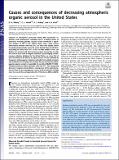| dc.contributor.author | Ridley, David Andrew | |
| dc.contributor.author | Heald, Colette L. | |
| dc.contributor.author | Ridley, K. J. | |
| dc.contributor.author | Kroll, Jesse | |
| dc.date.accessioned | 2018-10-12T18:10:44Z | |
| dc.date.available | 2018-10-12T18:10:44Z | |
| dc.date.issued | 2018-01 | |
| dc.date.submitted | 2017-01 | |
| dc.identifier.issn | 0027-8424 | |
| dc.identifier.issn | 1091-6490 | |
| dc.identifier.uri | http://hdl.handle.net/1721.1/118466 | |
| dc.description.abstract | Exposure to atmospheric particulate matter (PM) exacerbates respiratory and cardiovascular conditions and is a leading source of premature mortality globally. Organic aerosol contributes a significant fraction of PM in the United States. Here, using surface observations between 1990 and 2012, we show that organic carbon has declined dramatically across the entire United States by 25–50%; accounting for more than 30% of the US-wide decline in PM. The decline is in contrast with the increasing organic aerosol due to wildfires and no clear trend in biogenic emissions. By developing a carbonaceous emissions database for the United States, we show that at least two-thirds of the decline in organic aerosol can be explained by changes in anthropogenic emissions, primarily from vehicle emissions and residential fuel burning. We estimate that the decrease in anthropogenic organic aerosol is responsible for averting 180,000 (117,000–389,000) premature deaths between 1990 and 2012. The unexpected decrease in organic aerosol, likely a consequence of the implementation of Clean Air Act Amendments, results in 84,000 (30,000–164,000) more lives saved than anticipated by the EPA between 2000 and 2010. Keywords: carbonaceous aerosol; organic aerosol; PM mortality; anthropogenic emissions; long-term trends | en_US |
| dc.description.sponsorship | National Science Foundation (U.S.) (Grant AGS- 1238109) | en_US |
| dc.description.sponsorship | United States. National Aeronautics and Space Administration (Grant NNX14AP38G) | en_US |
| dc.description.sponsorship | United States. National Oceanic and Atmospheric Administration (Grant NA13OAR4310072) | en_US |
| dc.publisher | National Academy of Sciences (U.S.) | en_US |
| dc.relation.isversionof | http://dx.doi.org/10.1073/PNAS.1700387115 | en_US |
| dc.rights | Article is made available in accordance with the publisher's policy and may be subject to US copyright law. Please refer to the publisher's site for terms of use. | en_US |
| dc.source | PNAS | en_US |
| dc.title | Causes and consequences of decreasing atmospheric organic aerosol in the United States | en_US |
| dc.type | Article | en_US |
| dc.identifier.citation | Ridley, D. A. et al. “Causes and Consequences of Decreasing Atmospheric Organic Aerosol in the United States.” Proceedings of the National Academy of Sciences 115, 2 (December 2017): 290–295 © 2018 National Academy of Sciences | en_US |
| dc.contributor.department | Massachusetts Institute of Technology. Department of Chemical Engineering | en_US |
| dc.contributor.department | Massachusetts Institute of Technology. Department of Civil and Environmental Engineering | en_US |
| dc.contributor.department | Massachusetts Institute of Technology. Department of Earth, Atmospheric, and Planetary Sciences | en_US |
| dc.contributor.mitauthor | Ridley, David Andrew | |
| dc.contributor.mitauthor | Heald, Colette L. | |
| dc.contributor.mitauthor | Ridley, K. J. | |
| dc.contributor.mitauthor | Kroll, Jesse | |
| dc.relation.journal | Proceedings of the National Academy of Sciences | en_US |
| dc.eprint.version | Final published version | en_US |
| dc.type.uri | http://purl.org/eprint/type/JournalArticle | en_US |
| eprint.status | http://purl.org/eprint/status/PeerReviewed | en_US |
| dc.date.updated | 2018-09-26T11:56:32Z | |
| dspace.orderedauthors | Ridley, D. A.; Heald, C. L.; Ridley, K. J.; Kroll, J. H. | en_US |
| dspace.embargo.terms | N | en_US |
| dc.identifier.orcid | https://orcid.org/0000-0003-3890-0197 | |
| dc.identifier.orcid | https://orcid.org/0000-0003-2894-5738 | |
| dc.identifier.orcid | https://orcid.org/0000-0002-6275-521X | |
| mit.license | PUBLISHER_POLICY | en_US |
